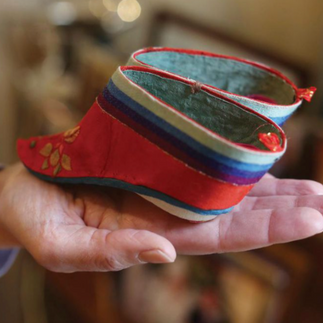Power, beauty, and lost languages
- linda85728
- May 21, 2024
- 4 min read

February 2021
Who is the secret committee that defines beauty?
“Social media, Hollywood, men,” some of us answered. We gathered in Zoom for our monthly book club; this month’s book: Snow Flower and the Secret Fan. The backdrop to our conversation was 1830s rural China and the story of two young girls – Lily and Snow Flower – as they navigated friendship, marriage, motherhood, and power dynamics that still resonate today.
In their villages, Lily’s and Snow Flower’s subordinate status, because of their gender, contrasted with their powerful roles as the only ones able to perpetuate their family lines (by birthing babies). The book prompted us to ask: Who has the real power? By and large we live in patriarchal societies. We raise our daughters to enforce social codes and government policies created mainly by men, even the policies that affect women’s bodies. Yet women have soft power. We are resilient. We adapt. We intuitively navigate context and complex systems. We enact soft power every day.
We talked about moments that we felt empowered, powerful, and powerless. A pearl of wisdom floated to the top of the Zoom room, like oxygen, when one member said, “Actions that are empowering can also be painful.” She was reflecting on a hard decision she recently made. We all agreed. We women make hard decisions. We clean up the fall-out, and we will better things into motion. We also asked each other: “If you haven’t had that empowering moment, what do you need to get there?” We committed to being a source of empowerment for each other.
Back to beauty: How do we as a culture define beauty? In the book, beauty was defined by the size of a young girl’s feet. The Chinese tradition of foot binding, said to have started in the 10th century and banned in 1912 (but continued in rural villages for years after), was for young girls at the time a means to rise in society. The emperor’s emissaries would travel the countryside collecting taxes, and if they came upon a girl with tiny feet, she might rise to the status of a concubine at court. Small feet became a status symbol. Yet when a girl’s feet were bound, it was a painful procedure. Her toes were broken and curled under the arch of her foot. It meant that she walked in pain for the rest of her life. She would be bound to her home physically, in the truest sense of the word, because she could not walk far.
The theme of pain for beauty resonated throughout our conversation. Ballet pointe shoes, high heels, and corsets – these are clothes that we women force our bodies to mold into, rather than creating clothes that mold around our natural bodies. We also reflected on how beauty is situational, cultural, and changes over time. It was once considered beautiful to be overweight as it was a sign of prosperity; now mainstream beauty is thin. Light skin was in, then dark skin, and so on. I recalled how my mother always spoke with pride of my fair skin when I was small, yet I did not understand why. The conversation also brought back a vivid memory, both poignant and funny, that I had not remembered in years.
When I was a teenager, my mother would visit Hong Kong, the city she immigrated from. She would come home with dozens of what I called “bullet bras”. They had unbelievably firm cups that transformed the wearer from AAA cups to solid C cups. My mom would advocate so hard for me to wear these. I remember saying, “Mom, don’t you think people will notice if I go from having a flat chest to a machine gun chest overnight?” She would chide me and tell me I would look beautiful.
I laughed out loud as I shared this story. Our guest speaker, Kathy Hsieh, Asian American actor, writer, and director, reveled in laughter with me at this memory. She too had been gifted these bullet bras. I was intrigued to learn from her that these bras had been designed to emulate the American barbie. This knowledge was so illuminating when considering the question of who defines beauty. In this case, it was an American barbie doll influencing the undergarments of ladies in Hong Kong, and the diaspora of first-generation Chinese girls the world-over!
Finally, we talked about lost languages. An extraordinary part of this month’s book was its integration of Nu Shu, a very real and secret language among women in the region at that time. Nu Shu, literally meaning “woman writing”, was created about 1,000 years ago, seemingly by concubines so they could write secretly to sisters outside of court. The language was passed through women: embroidered into textiles, written in small notebooks, or sung in songs. It was also very contextual – the same symbol could mean something different depending on the context of the message. I imagine it was an essential form of sisterhood between women as they were not formally taught to read or write. In 1949, following the founding of the People’s Republic of China, children started being taught Mandarin, and eventually, Nu Shu faded away. Sadly, the last Yao woman who spoke Nu Shu as her first language passed in 2004. Though I have read that some academics and women in China are mobilizing to preserve the language.
As our time together in book club came to an end, we spoke about the power of language: how it can have harmful consequences, such as the fraying of friendships when miscommunication is at play. Yet also how language can be inspiring, and empower us all, in particular, women. At the closing of the book, Lily, the matriarch in the story at the age of 80, speaks of how she continued the tradition of teaching women in her village the Nu Shu language, and even more, how she documented the stories of women’s lives. She charged them “three eggs and a piece of cash”, not because she needed the money, but because she wanted the women to place value on their lives.
“Women must tell their stories,” Kathy said. I wholeheartedly agree. I commit to telling my story, and lifting the stories of women around me and the sisterhoods I am part of. We have so many important stories to tell.









